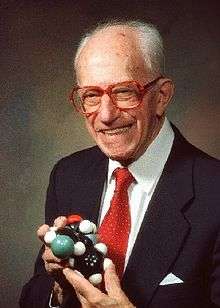Leo Sternbach
| Leo Henryk Sternbach | |
|---|---|
 | |
| Born |
May 7, 1908 Opatija, Austria-Hungary (now Croatia) |
| Died |
September 28, 2005 (aged 97) Chapel Hill, North Carolina, United States |
| Nationality | American Jew |
| Occupation | Chemist |
| Known for | Discovering benzodiazepines |
| Relatives |
Michael Abracham Sternbach (father) Piroska (née Cohn) Sternbach (mother) |
Leo Henryk Sternbach (May 7, 1908 – September 28, 2005) was a Croatian-born Jewish American chemist who is credited with discovering benzodiazepines, the main class of tranquilizers.[1]
Background and family

Sternbach was born on May 7, 1908, in Opatija, to a Jewish family. He had a younger brother, Giusi.[2] His father Michael Abracham Sternbach was from Polish city of Przemyśl in Galicia (then part of Austria-Hungary), and his mother Piroska (née Cohn) Sternbach was from Orosháza, Hungary. Sternbach's parents met and married in Opatija where they both lived. The family lived in a rented four-room apartment on the third floor of the "Vila Jadran" (Villa Adriatic), near the pharmacy owned by Sternbach's father. His family was an upper middle class Opatija family. In 1926, Sternbach moved with his family to Poland.[3][4]
Education and career
He received his master's degree in pharmacy in 1929 and his doctoral degree in organic chemistry in 1931 from the Jagiellonian University in Krakow, Poland. He left Poland because of increasing anti-Semitism. In Vienna he worked with Wolfgang Joseph Pauli (Sr.) and Sigmund Fränkel; after which he worked with Leopold Ružička at the Swiss Federal Institute of Technology in Zurich. Moving to Basel, Switzerland, he worked with Hoffmann-La Roche and married Herta Kreuzer. In 1941, he moved to the United States to work with Hoffmann-La Roche in Nutley, New Jersey, thus escaping the Nazis.[5]
While working for Hoffmann-La Roche in Nutley, New Jersey, Sternbach did significant work on new drugs. He is credited with the discovery of chlordiazepoxide (Librium), diazepam (Valium), flurazepam (Dalmane), nitrazepam (Mogadon), flunitrazepam (Rohypnol), clonazepam (Klonopin), and trimethaphan (Arfonad). Librium, based on the R0 6-690 compound discovered by Sternbach in 1956, was approved for use in 1960. In 1963, its improved version, Valium, was released and became astonishingly popular: between 1969 and 1982, it was the most prescribed drug in America, with over 2.3 billion doses sold in its peak year of 1978. With Moses Wolf Goldberg, Sternbach also developed "the first commercially applicable" method for synthesizing biotin.[6]
Sternbach held 241 patents, and his discoveries helped to turn Roche into a pharmaceutical industry giant. He did not become wealthy from his discoveries, but he was happy; he treated chemistry as a passion and said, "I always did just what I wanted to do". He went into the office until he was 95. Sternbach was a longtime resident of Upper Montclair, New Jersey, from 1943 to 2003. He then moved to Chapel Hill, North Carolina, where he died in 2005.[7][8]
Legacy
A book Good chemistry: The life and legacy of Valium inventor Leo Sternbach was published by McGraw-Hill in 2004.
Sternbach's uncle, Leon Sternbach, the brother of Sternbach's father Michael, was a professor of classical philology at Jagiellonian University. He was murdered in 1940 in the Nazi Sachsenhausen concentration camp as the result of the Nazi action against Polish academic teachers called Sonderaktion Krakau. His killer was Gustav Sorge.
He is present in the New Jersey Inventor's Hall of Fame; and was inducted into the National Inventors Hall of Fame in February 2005, a few months before his death.[9] Sternbach is a member of the Medicinal Chemistry Hall of Fame.[10]
References
- ↑ Alex Baenninger; "Good chemistry: The life and legacy of valium inventor Leo Sternbach", New York : McGraw-Hill, 2004. ISBN 0-07-142617-5
- ↑ (Croatian) Ha-Kol (Glasilo Židovske zajednice u Hrvatskoj); Sanja Dukić; Povratak velikana u rodnu Opatiju; stranica 40, 41; broj 94, svibanj / lipanj 2006.
- ↑ (Croatian) Ha-Kol (Glasilo Židovske zajednice u Hrvatskoj); Sanja Dukić; Opatijsko djetinjstvo dr. Lea Sternbacha; stranica 42, 43, 44; broj 94, svibanj / lipanj 2006.
- ↑ Acta Medico-Historica Adriatica; Sanja Simper; Dr. Leo Henryk Sternbach's childhood in Opatija ((Croatian) Opatijsko djetinjstvo Dr. Lea Henryka Sternbacha); stranica 92 - 103; 2007.
- ↑ Koeppel, Tonja A. (March 12, 1986). "Interview with Leo H. Sternbach". Center for Oral History. Chemical Heritage Foundation.
- ↑ Bonrath W, et al. (May 2009). "Biotin: The Chiral Challenge". CHIMIA International Journal for Chemistry. 63 (5). pp. 265–269.
- ↑ Pearce, Jeremy. "Leo Sternbach, 97, Valium Creator, Dies", The New York Times, October 1, 2005. Accessed October 17, 2007. "The couple lived in Upper Montclair, N.J., until last year, when they moved to Chapel Hill."
- ↑ Inventor of Valium and National Inventors Hall of Fame, Roche, September 30, 2005. Accessed October 17, 2007. "A devoted family man, Sternbach lived with his wife, Herta, in Upper Montclair, New Jersey, from 1943 to 2003..."
- ↑ "National Inventors Hall of Fame announces 2005 inductees", Medical News Today, February 12, 2005. Accessed October 17, 2007.
- ↑ "Medicinal Chemistry Hall of Fame". Medicinal Chemistry Division, American Chemical Society. Retrieved 31 August 2012.